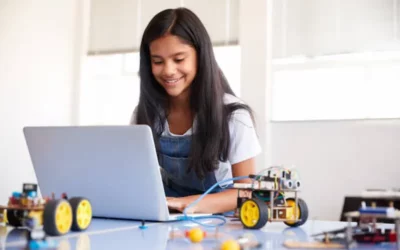Coding is the language of the future, and it’s no longer just for computer scientists or engineers. It’s for everyone, including kids. Learning to code at a young age unlocks creativity and career potential.
It develops problem-solving skills, critical thinking, resilience, entrepreneurship, teamwork, and creativity. It’s also fun and engaging! In this blog post, we’ll explore why your child should learn to code and how it can benefit them in the long run.
Before diving into the blog, You can check out the video.
We’ll also cover where to find resources for young coders, basic computer programming for kids languages that are kid-friendly, and how to get kids interested in programming concepts. Plus, we’ll answer frequently asked questions like what age kids should start learning to code and whether coding requires a strong math background. Let’s dive in!
Table of contents
- Introduction
- Benefits of Learning to Code for Kids
- Popular Coding Languages for Kids
- Coding Games and Projects for Kids
- Tips for Teaching Kids to Code
- Common Challenges and How to Overcome Them
- Resources for Parents and Educators
- Challenges and Opportunities in Teaching Kids to Code
- Conclusion
- Frequently Asked Questions (FAQs)
Introduction
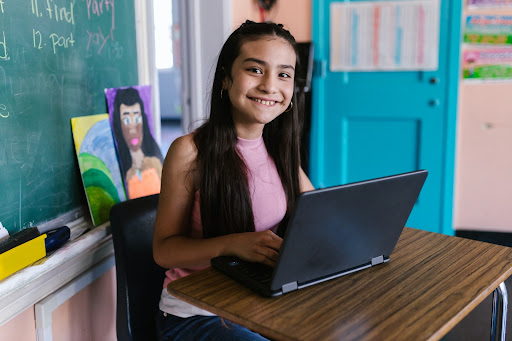
Learning to code at a young age can have numerous benefits for kids, both in terms of their creativity and career potential. By learning to code, children can develop critical thinking skills, problem-solving abilities, and logical reasoning abilities.
These skills are becoming increasingly important in today’s job market, and exposure to coding early on can lead to greater interest and opportunity in STEM fields.
Learning to code can also be an enjoyable and engaging activity that allows kids to express themselves creatively while building valuable skills for the future.
Why should kids learn how to code?
In today’s world, where technology is evolving at an unprecedented rate, coding has become a crucial skill that can set kids apart from their peers. More than just a technical skill, learning to code can help kids develop problem-solving skills computational thinking and critical thinking skills for kids.
With coding skills in demand across many industries, including finance, healthcare, and technology, teaching kids to code at a young age can give them an advantage as they progress through their education and careers.
Additionally, coding can inspire creativity and allow kids to build their own digital creations, helping them unlock their full potential.
How can coding unlock creativity and career potential?
Learning to code at a young age can have far-reaching benefits on both creativity and career potential. Not only does coding encourage logical thinking, but it also promotes problem-solving and perseverance, skills that are highly valued in many industries.
Additionally, coding equips children with the necessary knowledge and tools to bring their creative ideas to life, inspiring innovation and entrepreneurship.
As technology continues to permeate all industries, learning to code can help children develop the skills they need for future success and high-paying job opportunities.
Benefits of Learning to Code for Kids
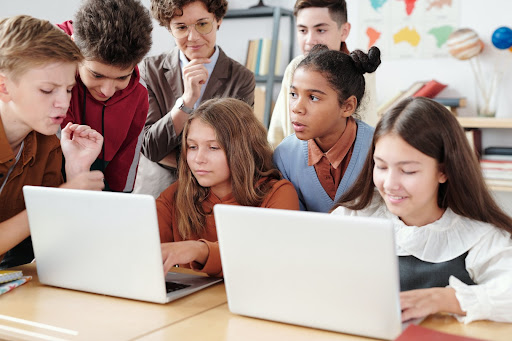
Learning to code can have a significant impact on kids’ cognitive development, problem-solving skills, and digital literacy. By learning programing for kids languages at a young age, children can break down complex problems into smaller parts and develop the ability to think logically.
They can also gain an understanding of how technology works and learn to build their own digital creations. Furthermore, coding can be a fun and creative outlet for kids, allowing them to express themselves while developing valuable skills that may lead to future career opportunities in technology.
Problem-Solving Skills
Learning to code can be an excellent way to develop problem-solving skills in kids. Coding involves breaking down complex problems into smaller, more manageable parts, which is a valuable skill in many aspects of life.
By learning how to approach problems logically and systematically, kids can apply these skills to other areas of study and future careers. Moreover, coding teaches trial-and-error and perseverance, which helps kids develop a growth mindset toward problem-solving.
These skills can go a long way in building confidence and independence in young learners as they work through challenges on their own.
Critical Thinking
Learning to code can help kids develop critical thinking skills by breaking down complex problems into smaller, more manageable parts. This encourages a logical and analytical approach to problem-solving that can be applied in many different areas of life.
The skills learned through coding can help kids gain confidence in their ability to solve problems and think creatively. Additionally, coding teaches the importance of perseverance and patience when working through difficult challenges, which are essential qualities for success not just in coding but also in life.
These critical thinking skills can be applied to future careers, making learning to code an investment in a child’s future.
Resilience
Learning to code requires patience, dedication, and a willingness to try again after failing. These qualities build resilience in children, helping them learn how to approach challenges with a growth mindset.
When coding, mistakes are inevitable; however, the process of identifying and correcting errors is an essential part of writing functional code. This iterative process teaches kids that failure is not only acceptable but necessary for learning and improvement.
As children become more comfortable with this idea, they will begin to see setbacks as opportunities for growth rather than sources of frustration or discouragement.
Entrepreneurship
Learning to code can provide kids with valuable skills for entrepreneurship. By developing problem-solving and critical thinking skills through coding, kids may be more likely to adopt an entrepreneurial mindset and pursue their own business ventures in the future.
Furthermore, coding skills are increasingly in demand across many industries, making them a valuable asset for any aspiring entrepreneur. Additionally, learning to code can help kids become more self-sufficient and confident, both of which are essential traits for successful entrepreneurs.
Overall, coding is a fun and engaging way for kids to develop skills that can benefit them in a variety of areas throughout their lives.
Teamwork
Working on coding projects can help children develop teamwork skills and become more effective at collaborating with others. By working together with peers, kids can learn how to communicate effectively, delegate tasks, and work towards a common goal.
This promotes the sharing of knowledge and provides an opportunity for kids to learn from one another.
Additionally, learning to code in a team environment will give children essential life skills that will benefit them in their future careers as well as personal relationships.
Creativity
Learning to code can help children develop their creativity by allowing them to express their ideas through coding. As they learn the various programming languages, they begin to realize that there is no one right way to solve a problem.
This encourages them to experiment with different approaches and come up with unique solutions. Additionally, coding requires perseverance, as children often encounter bugs or errors that need to be fixed. By working through these challenges, children develop resilience and a willingness to try new ideas.
Overall, learning to code can be a fun and engaging way for kids to explore their creativity while building valuable skills for the future.
Fun and Engaging
Learning to code can be a fun and engaging activity for kids. It provides them with the opportunity to use their creativity and problem-solving skills in a completely new way.
Unlike other subjects, coding is all about experimentation and learning from mistakes, which can make it exciting for young learners. By mastering the basics of programming, kids can create their own games, animations, and even websites.
Additionally, coding helps children develop critical thinking and logic skills that are valuable in many aspects of life. Therefore, introducing kids to coding at an early age can be both enjoyable and beneficial for their future development.
Popular Coding Languages for Kids
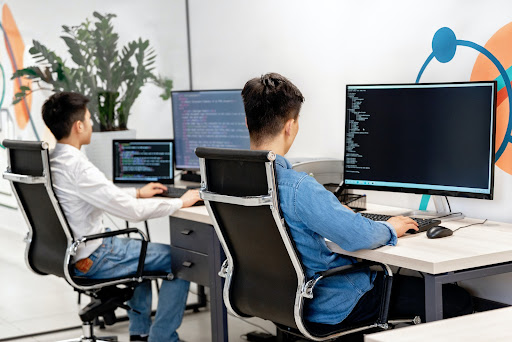
Coding has become a necessary talent in the current digital age, and it’s never too early to introduce children to the world of programming. Learning to code fosters creativity, logical reasoning, and critical thinking skills in addition to critical thinking and problem-solving skills.
Several coding languages have been created expressly for children to make learning fun and interesting. Three well-liked coding languages for kids will be covered in this blog section: JavaScript, Python, and Scratch.
Additionally, we will offer helpful tools for learning each language, such as projects, games, and tutorials.
Scratch
The MIT Media Lab created the visual programming language Scratch. Kids can use it to make animations, games, and interactive stories on a fun and engaging platform.
Scratch makes coding simple with its vibrant drag-and-drop building blocks and allows kids as young as 8 to make their own creations.
Resources for learning Scratch
ScratchJr
ScratchJr is a condensed version of Scratch that is accessible as tablet software for kids ages 5 to 7, allowing them to make their own interactive stories and free coding games for kids.
Python
Python, a popular and approachable language for beginners, is a fantastic choice for kids to start their coding journey. Python, which is renowned for its clear syntax, enables new programmers to concentrate on solving problems rather than learning difficult syntax rules.
Kids may use Python programming for kids to develop games, design graphical user interfaces, and even manage actual physical things like robots.
Resources for learning Python
Codecademy
Codecademy provides a free interactive Python course with step-by-step instructions and coding activities that are specially created for children.
Python.org
The official Python website, Python.org, has a variety of resources for newcomers, including tutorials and documentation.
Turtle graphics
Children may create vibrant images and animations using Python’s built-in Turtle module, which makes learning the language both fun and educational.
JavaScript
If your child is interested in web design and building interactive websites, JavaScript is a fantastic option. Young programmers can create web pages, games, and dynamic components for their projects using JavaScript. It provides countless chances for imagination and discovery.
Resources for learning JavaScript
Khan Academy
Interactive JavaScript tutorials from Khan Academy walk children through the fundamentals and let them build their own web-based applications.
Code.org
JavaScript is only one of the best coding classes for kids available at Code.org, which also features fun challenges and games for kids of all ages.
P5.js
Kids can play with dynamic images and animations with P5.js, a JavaScript package that makes creative coding easier.
Coding Games and Projects for Kids
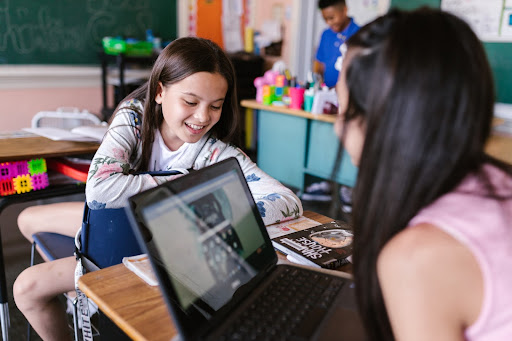
Coding has become a crucial skill for kids to learn in the modern digital age. Thankfully, learning to code doesn’t have to be a time-consuming or difficult endeavor. We can make learning fun and interesting for kids by introducing coding games and projects.
Scratch Maze Game
The Scratch Maze Game is a fun way for kids to get started with the block-based programming language Scratch. To guide a character through a maze and out the other side is the game’s goal. Children will gain knowledge of conditionals, sequencing, and fundamentals of game design. To create this thrilling game, adhere to the offered step-by-step instructions.
Python Turtle Graphics
Python is a popular programming language, and its turtle graphics module is an excellent resource for teaching young children the fundamentals of programming. Children may make vibrant, interactive drawings using turtle graphics. They’ll show you how to use Python’s turtle module to make a straightforward drawing, such as a spiral or a star. Children will learn about loops, functions, and coordinate systems with this project.
Web Development: HTML and CSS
Web development, which uses HTML and CSS, is another branch of coding that appeals to young people. Kids can make their own web pages using the foundational web design languages of HTML and CSS. They start by explaining the fundamentals of HTML to them, including headings, paragraphs, and graphics. Introduce CSS after that to style and improve their websites with different colors, fonts, and layouts.
Create a Virtual Pet
Create a virtual pet to bring the joy of pet ownership to the digital world. Kids will learn about object-oriented programming concepts with this project. They’ll design a digital pet with engaging capabilities like feeding, playing, and mood monitoring. Children will gain knowledge of classes, objects, and event handling by creating and programming their own pets. Create a charming virtual pet that will occupy and amuse kids by following our instructions.
Minecraft Modding
The kid-friendly game Minecraft presents a great opportunity to learn how to code through modding. Kids can modify games to change them and add new features. They’ll look at tools like Minecraft: Education Edition and manuals that detail the process of making unique Minecraft mods.
Children will have the opportunity to code their own special characters, tools, and building blocks, demonstrating their creativity while learning the fundamentals of coding.
Tips for Teaching Kids to Code

Kids who learn to code not only develop problem-solving skills but also have a greater appreciation for technology. For both parents and teachers, teaching coding to children can be a gratifying and fascinating experience.
Start with Engaging and Interactive Tools
It’s critical to make learning to code interesting and engaging for children. For example, Scratch, Code.org, and Blockly are just a few of the many coding environments and resources available for kids.
Kids may make animations, games, and interactive stories using these platforms’ visually appealing and user-friendly interfaces. Such technologies can be used to pique their attention and promote active involvement.
Break Concepts Down Into Bite-Sized Pieces
Coding can be intimidating for novices, so it’s important to divide concepts into manageable chunks. Gradually introduce coding principles, building on each prior course.
Start with fundamental ideas like loops and sequencing, then progressively move on to more intricate concepts like variables and conditional expressions.
Children can learn the basics of coding with this gradual method without getting overwhelmed.
Encourage Creativity and Problem-solving
Bringing ideas to life is one of the most fascinating aspects of coding. Through coding projects, inspire children to use their imagination and think imaginatively. Give them problems with open-ended solutions that call for problem-solving abilities.
This encourages creative problem-solving, resilience, and critical thinking. Honor their accomplishments while emphasizing the need of making mistakes in the learning process.
Encourage teamwork and peer learning
Coding can be a team activity. Encourage youngsters to collaborate on coding projects so they may share ideas and learn from one another. There are options for peer learning and cooperation by organizing group activities or coding clubs.
Children with varying ability levels can be paired up to create a supportive environment and help them develop their communication and teamwork skills.
Relate Coding to Real-world Applications
Connect coding concepts to practical applications in order to make coding meaningful and relevant to children. Talk about how coding is employed in robots, video games, smartphone apps, and even commonplace activities like task automation. Children are interested and motivated to learn more after learning the usefulness and possible effects of coding in numerous industries.
Personalise Instruction and Projects
Let kids work on coding assignments that suit their interests. Whether it’s making a video game, a website, or a mobile app, letting youngsters pick their own projects feeds their enthusiasm and sense of pride.
Make the learning experience more personalized for them by directing them to tutorials and materials that are relevant to the project they have chosen. This personalization increases interest and enables kids to relate coding to their interests.
If you want your kids to truly experience the adventures of coding in a fresh environment, you can also look for coding camps for kids near me.
Common Challenges and How to Overcome Them

Both parents and educators are aware of how critical coding is to children’s future success. However, many parents and teachers have difficulties while attempting to teach their kids or students how to code. In this blog area, we’ll talk about typical difficulties that parents and teachers run into and look at solutions.
Challenges Facing Parents and Teachers
Lack of Knowledge
A major issue that instructors and parents frequently encounter is a lack of coding knowledge or comprehension. Teaching children something they are unfamiliar with can be scary because the majority of parents and educators did not learn to code as youngsters.
Limited Resources
Many homes and schools lack the tools or supplies required to teach coding. This can involve having access to computers and software as well as not having enough money for training or hiring a professional to teach coding.
Time Restrictions
Parents’ other obligations may make it difficult for them to devote as much time as they would like to teach their children to code. Teachers frequently have a limited amount of time to teach coding.
Motivation
It can be difficult to inspire and motivate kids to learn how to code, especially if they don’t understand the immediate advantages or uses of their knowledge.
Ways to Overcome Coding Skills Challenges
Professional Development
Teachers can take part in coding workshops and learning programs for kids to learn more about the subject. To better their understanding of coding and teaching abilities, parents can also enroll in online courses and tutorials.
Community Resources
There are a variety of options in many towns, such as coding clubs or regional businesses that provide no-cost or inexpensive coding courses. These tools can be used by parents, educators, and students to support their own work.
Online Resources
A variety of free coding websites and apps are accessible to instructors and parents to aid in the teaching of coding. These websites frequently contain interesting and interactive courses made to make learning to code enjoyable and approachable.
Collaboration
In order to help kids learn to code, teachers and parents can cooperate to share information and resources. In the community or at the school, this may entail starting a coding club or establishing a parent-teacher association. You can also look for a coding school for kids that they can join in their summer breaks.
Gamification
Programming games for kids and competitiveness appeal to kids frequently. Gamification strategies can be used by parents and educators to make coding more interesting and enjoyable. This can involve developing coding challenges, providing incentives or prizes, and incorporating coding into other tasks and topics.
Resources for Parents and Educators

Giving kids basic skills like coding and encouraging a love of learning is essential in an increasingly digital environment. In directing and fostering the development of young minds, parents and educators are crucial.
Fortunately, there are many tools out there that may help parents and teachers in their effort to give their children the greatest possible educational opportunities. These tools, which range from coding books to interactive applications and online classes, provide a plethora of information and inspiration.
Coding Books
“Hello Ruby” by Linda Liukas
It is a charming book that educates young kids on the basics of programming through interactive exercises and stories.
“Coding Projects in Python” by DK
This book, which is best suited for older kids, provides step-by-step instructions for developing websites, apps, and games using the Python programming language.
“JavaScript for Kids” by Nick Morgan
It provides a fun and approachable introduction to JavaScript that is aimed at older children and teenagers.
Coding Apps
“Scratch” by the MIT Media Lab
It is an approachable platform that enables kids to build interactive tales, games, and animations by connecting vibrant coding blocks. It is one of the best coding apps for kids.
“Tynker” by Tynker
Tynker provides a selection of interactive puzzles and coding lessons for kids so that they can learn programming fundamentals while creating games and projects.
CodeSpark’s “CodeSpark Academy”
This software, which was created for younger kids, provides coding tasks and games that improve logical reasoning and problem-solving abilities. This coding app for kids can really help your kids to understand the fundamentals of coding.
Online coding classes
Code.org
Code.org provides K–12 students with a comprehensive curriculum and a range of courses suited for various age groups and skill levels.
Khan Academy
Known for its extensive library of instructional resources, Khan Academy offers coding classes on a variety of subjects, from basic ideas to complex programming languages.
Coursera
Coursera allows students of all ages to gain in-depth programming skills by providing online coding courses from leading colleges and institutions.
Educational Websites
National Geographic Kids
National Geographic Kids, which provides a plethora of articles, videos, and interactive activities on a range of topics, including science, geography, and animals.
PBS LearningMedia
For teachers, parents, and students, PBS LearningMedia offers free access to a sizable library of educational resources, including videos, lesson plans, and interactive games.
Khan Academy Kids
This free, evidence-based software for kids covers a variety of topics, including maths, reading, science, and social-emotional development.
STEM kits and toys include
LittleBits
LittleBits offers electrical blocks that let kids experiment and build their own inventions while learning about circuits and engineering.
LEGO Education
Offering a variety of STEM-based kits and sets, LEGO Education encourages creativity and problem-solving abilities through play and hands-on learning experiences.
Ozobot
Ozobot sells miniature programmable robots that let kids learn how to code using either block-based or visual programming.
Challenges and Opportunities in Teaching Kids to Code
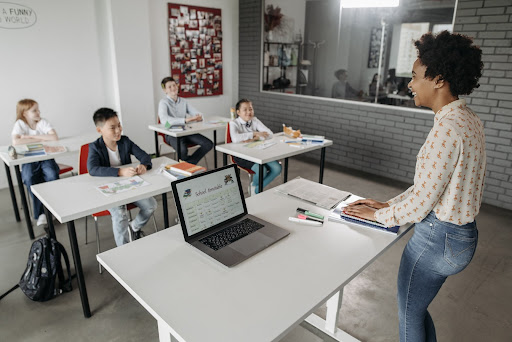
Teaching children to code not only gives them a vital skill set but also encourages creativity, critical thinking, and problem-solving skills as technology continues to influence our society. But teaching coding to kids is not without its difficulties.
Overcoming the Fear of Complexity
Teaching children to code has several obstacles, one of which is helping them overcome their fear of complexity. Children may initially feel intimidated by coding languages since they seem daunting.
However, this difficulty can be overcome by utilizing kid-friendly platforms, video games, and programming languages with visual elements. These tools can increase accessibility and interest in coding, letting children develop their confidence while learning at their own speed.
Promoting Engagement and Interest
It can be difficult to keep kids interested in and involved in coding sessions. In order to combat this, instructors must create engaging, hands-on activities that make coding fun.
Kids can feel motivated and accomplished by incorporating project-based learning, where they can make games, animations, and applications.
Additionally, including aspects of storytelling in coding sessions might help young minds find the learning process more engaging and relatable.
Adapting to Diverse Learning Styles
Effective coding education must take into account the fact that children have a variety of learning preferences. While some children may benefit more from visual clues or hands-on activities, others could prefer auditory explanations or visual cues.
In order to overcome this difficulty, teachers can offer a variety of learning materials, including video lessons, interactive games, and group discussions. Teachers may guarantee that all students have an equal opportunity to study and succeed by utilizing a variety of modalities
Fostering Collaboration and Problem-Solving Skills
Coding is more than just writing lines of code; it also requires certain skills. Kids can acquire these crucial skills by being encouraged to work in teams and participate in peer learning activities.
Children can work together, share ideas, and resolve issues collectively in an environment that is created through group coding projects, coding clubs, or coding competitions. These opportunities develop the cooperation, resilience, and communication skills that are so important in the profession of coding.
Addressing the Gender Gap
One other difficulty in teaching children to code is taking on the gender divide that exists in the tech sector. Particularly women are underrepresented in the fields of computer science and coding. It is essential to establish a gender-inclusive learning environment in order to overcome this obstacle.
Role models can be presented, successful women in IT can be highlighted, and programs with a focus on girls can be implemented by educators. More young girls can be inspired to learn how to code by encouraging diversity and inclusivity. Additionally, enrolling in a coding class online for kids can provide a supportive and accessible environment for girls to develop their coding skills.
Conclusion
Learning to code as a child not only enhances their creativity but also opens up a world of career opportunities. It helps children develop essential problem-solving, critical thinking, and team-building skills that are vital for success in the modern world. With so many free and paid resources available, it has never been easier for kids to start learning how to code.
Giving kids the skills to code helps them develop their logic and problem-solving abilities, but it also nurtures creativity, encourages invention, and opens up a world of possibilities. We will emphasize the significance of teaching young children to code and the numerous advantages it provides in this blog.
In order to assist their kids succeed in the world of coding, we’ll also encourage parents and teachers to make use of the tools listed in the Code for Kids guide.
The Power of Coding
Enhancing Problem-Solving Skills
Coding is fundamentally the process of breaking down big problems into smaller, more manageable jobs, which helps to improve problem-solving abilities. Children who learn to code have a methodical and analytical approach to problem-solving, enabling them to face obstacles with assurance and tenacity.
Fostering Creativity and Innovation
Children who learn to code are able to express their creativity by turning their imaginative ideas into real-world digital projects. Children learn to think creatively, experiment, and realize their ideas through code. As a result, they are inspired to innovate and explore new possibilities in the ever-changing world of technology.
Building Logical Reasoning
Because it takes a sequential and step-by-step method to obtain desired results, coding is built on logical reasoning. Children that learn to code acquire logical reasoning abilities like cause and effect knowledge, forming connections, and outcome prediction.
These abilities are useful not only for coding but also in many other academic and practical contexts.
Promoting Collaboration and Communication
Working on projects as a team is a common aspect of programming, necessitating efficient collaboration and communication. Children develop their ability to collaborate, exchange ideas, listen to others, and clearly convey their views and concepts through participating in coding activities.
In the linked world of today, when success depends on working as a team, these collaboration abilities are critical.
Opening Doors to Opportunities
In the Future Coding abilities are highly sought after across many businesses in a world that is becoming more and more digital. Children who learn to code get vital skills that may open up career prospects for them in the future.
Coding expertise gives job seekers an advantage in the hiring process, regardless of whether they want to work in the field of software development, data analysis, or another tech-related industry.
The future of children can be powerfully impacted by teaching them to code. We can enable kids to become innovators and problem solvers in the digital age by teaching them coding skills. Coding has advantages that go beyond technology since it fosters critical thinking, creativity, teamwork, and communication abilities.
It is our duty as educators and parents to embrace this digital age and give our kids the tools and resources they need to succeed.
Enter the realm of CodeChamps, an extraordinary coding program crafted by the brilliant minds at BrightChamps. Brace yourself for an exhilarating journey into the captivating world of technology. Through a tapestry of interactive lessons, hands-on experimentation, and mind-bending challenges, CodeChamps unveils the hidden secrets of programming. From breathing life into captivating games and crafting awe-inspiring websites to unraveling the mysteries of robotics and app development, CodeChamps unlocks a universe of endless possibilities. Embrace the power of CodeChamps and witness your child transcend into a coding prodigy, ready to shape the future with their unparalleled technological brilliance.
Frequently Asked Questions (FAQs)
Ans 1. Coding is the process of creating software, websites, apps, and other things by writing instructions that computers can understand. Because it fosters the development of critical thinking, creativity, and problem-solving abilities in children, learning to code gives them the power to influence the future of a technologically advanced society.
Ans 2. By engaging in activities that promote computational thinking at an appropriate age, children can begin learning to code as early as preschool. However, formal coding instruction can start between the ages of 7 and 9, when kids are more adept in reading and maths.
Ans 3. Kids can gain a lot from coding, including better analytical and critical thinking skills, increased creativity and innovation, enhanced problem-solving skills, promoted logical reasoning, increased perseverance and resilience, and preparation for technology-related careers in the future.
Ans 4. Children can learn a number of coding languages, including:
1. Scratch:
It is a beginner-friendly visual programming language.
2. Python:
A flexible, understandable language with an easy-to-understand syntax.
3. JavaScript:
A programming language for creating dynamic websites.
4. Blockly:
A block-based language with varying implementations that is comparable to Scratch.
Ans 5. In order to help their children learn to code, parents can:
1. Encourage and cultivate a positive attitude towards coding.
2. Giving people access to resources for learning how to code, such as books, online courses, or boot camps.
3. Collaborating on code projects and expressing interest in their development.
4. Establishing a coding-friendly environment with specialized equipment and a workstation.
5. Praising accomplishments and providing advice as required.
You can also look for coding for kids near me to engage your kids in immersive learning experiences.
Ans 6. The price of coding programs for children might vary depending on a number of elements, including the venue, length, standard, and type of session (in-person or online). Some coding courses could be free, while others might have a fee that ranges from moderate to high.
It’s a good idea to investigate and contrast several coding programs to locate alternatives that are within your price range. Additionally, there are numerous online tools and courses that may teach kids how to code for little to no expense.
Ans 7. Definitely! In today’s digital age, coding abilities are becoming more and more valuable. Your youngster may be able to pursue a wide range of job options in industries including software development, web design, data science, artificial intelligence, and more.
Ans 8. A child’s learning curve for coding varies depending on their age, rate of learning, perseverance, and the difficulty of the coding ideas they are attempting to understand. However, with constant practice and dedication, kids can begin developing fundamental coding abilities within a few weeks or months.
Ans 9. Children can be inspired and engaged by a variety of entertaining coding projects. Here are some suggestions:
1. Utilising Scratch or another visual programming language to create a straightforward game.
2. Making a blog or personal website with HTML and CSS.
3. Creating and programming a basic chatbot using Chatfuel or Dialogflow as a development environment.
4. Employ resources like MIT App Inventor or Thunkable to create a mobile application.
5. Employing tools like Roblox Studio or Minecraft: Education Edition to alter and customize current video games.
Ans 10. Yes, there are coding contests and activities made especially for kids to display their ingenuity and skills. Examples that stand out include:
FIRST LEGO League (FLL): It is a robotics competition in which youth-led teams construct and program robots to carry out predetermined objectives.
Hour of Code by Code.org: A yearly event that inspires children to start coding through a range of entertaining and engaging activities.
Google Code-in: A competition where students between the ages of 13 and 17 code for open-source projects.
Technovation Challenge: An international contest that encourages girls to create and present concepts for mobile applications that address societal issues.

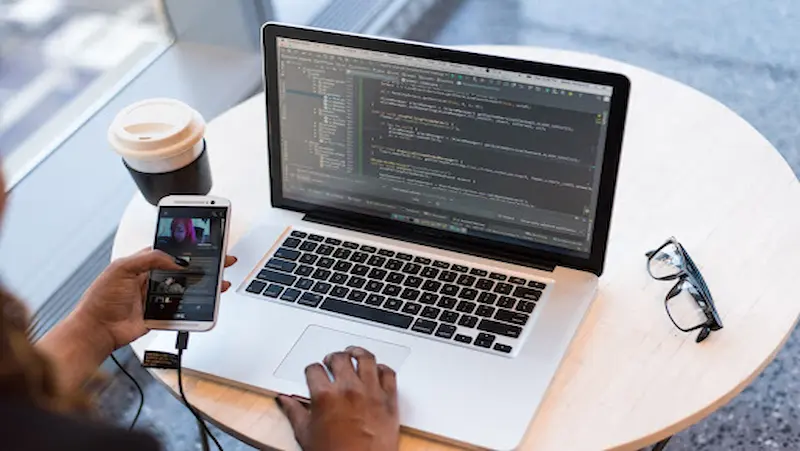
 We are an army of educators and passionate learners from BrightChamps family, committed to providing free learning resources to kids, parents & students.
We are an army of educators and passionate learners from BrightChamps family, committed to providing free learning resources to kids, parents & students.











